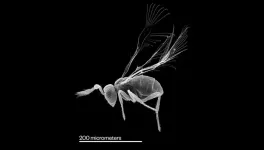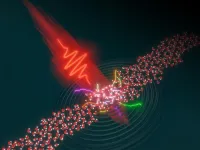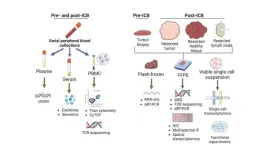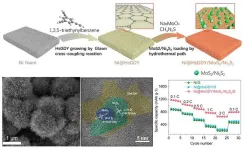(Press-News.org) CAMBRIDGE, MA -- Alzheimer’s disease affects more than 6 million people in the United States, and there are very few FDA-approved treatments that can slow the progression of the disease.
In hopes of discovering new targets for potential Alzheimer’s treatments, MIT researchers have performed the broadest analysis yet of the genomic, epigenomic, and transcriptomic changes that occur in every cell type in the brains of Alzheimer’s patients.
Using more than 2 million cells from more than 400 postmortem brain samples, the researchers analyzed how gene expression is disrupted as Alzheimer’s progresses. They also tracked changes in cells’ epigenomic modifications, which help to determine which genes are turned on or off in a particular cell. Together, these approaches offer the most detailed picture yet of the genetic and molecular underpinnings of Alzheimer’s.
The researchers report their findings in a set of four papers appearing today in Cell. The studies were led by Li-Huei Tsai, director of MIT’s Picower Institute for Learning and Memory, and Manolis Kellis, a professor of computer science in MIT’s Computer Science and Artificial Intelligence Laboratory (CSAIL) and a member of the Broad Institute of MIT and Harvard.
“What we set out to do was blend together our computational and our biological expertise and take an unbiased look at Alzheimer’s at an unprecedented scale across hundreds of individuals — something that has just never been undertaken before,” Kellis says.
The findings suggest that an interplay of genetic and epigenetic changes feed on each other to drive the pathological manifestations of the disease.
“It’s a multifactorial process,” Tsai says. “These papers together use different approaches that point to a converging picture of Alzheimer’s disease where the affected neurons have defects in their 3D genome, and that is causal to a lot of the disease phenotypes we see.”
A complex interplay
Many efforts to develop drugs for Alzheimer’s disease have focused on the amyloid plaques that develop in patients’ brains. In their new set of studies, the MIT team sought to uncover other possible approaches by analyzing the molecular drivers of the disease, the cell types that are the most vulnerable, and the underlying biological pathways that drive neurodegeneration.
To that end, the researchers performed transcriptomic and epigenomic analyses on 427 brain samples from the Religious Orders Study/Memory and Aging Project (ROSMAP), a longitudinal study that has tracked memory, motor, and other age-related changes in older people since 1994. These samples included 146 people with no cognitive impairment, 102 with mild cognitive impairment, and 144 diagnosed with Alzheimer’s-linked dementia.
In the first Cell paper, focused on gene expression changes, the researchers used single-cell RNA-sequencing to analyze the gene expression patterns of 54 types of brain cells from these samples, and identified cellular functions that were most affected in Alzheimer’s patients. Among the most prominent, they found impairments in the expression of genes involved in mitochondrial function, synaptic signaling, and protein complexes needed to maintain the structural integrity of the genome.
This gene expression study, which was led by former MIT postdoc Hansruedi Mathys, graduate student Zhuyu (Verna) Peng, and former graduate student Carles Boix, also found that genetic pathways related to lipid metabolism were highly disrupted. In work published in Nature last year, the Tsai and Kellis labs showed that the strongest genetic risk for Alzheimer’s, called APOE4, interferes with normal lipid metabolism, which can then lead to defects in many other cell processes.
In the study led by Mathys, the researchers also compared gene expression patterns in people who showed cognitive impairments and those who did not, including some who remained sharp despite having some degree of amyloid buildup in the brain, a phenomenon known as cognitive resilience. That analysis revealed that cognitively resilient people had larger populations of two subsets of inhibitory neurons in the prefrontal cortex. In people with Alzheimer’s-linked dementia, those cells appear to be more vulnerable to neurodegeneration and cell death.
“This revelation suggests that specific inhibitory neuron populations might hold the key to maintaining cognitive function even in the presence of Alzheimer’s pathology,” Mathys says. “Our study pinpoints these specific inhibitory neuron subtypes as a crucial target for future research and has the potential to facilitate the development of therapeutic interventions aimed at preserving cognitive abilities in aging populations.”
Epigenomics
In the second Cell paper, led by former MIT postdoc Xushen Xiong, graduate student Benjamin James, and former graduate student Carles Boix PhD ’22, the researchers examined some of the epigenomic changes that occurred in 92 people, including 48 healthy individuals and 44 with early or late-stage Alzheimer’s. Epigenomic changes are alterations in the chemical modifications or packaging of DNA that affect the usage of a particular gene within a given cell.
To measure those changes, the researchers used a technique called ATAC-Seq, which measures the accessibility of sites across the genome at single-cell resolution. By combining this data with single-cell RNA-sequencing data, the researchers were able to link information about how much a gene is expressed with data on how accessible that gene is. They could also start to group genes into regulatory circuits that control specific cell functions such as synaptic communication — the primary way that neurons transmit messages throughout the brain.
Using this approach, the researchers were able to track changes in gene expression and epigenomic accessibility that occur in genes that have previously been linked with Alzheimer’s. They also identified the types of cells that were most likely to express these disease-linked genes, and found that many of them occur most often in microglia, the immune cells responsible for clearing debris from the brain.
This study also revealed that every type of cell in the brain undergoes a phenomenon known as epigenomic erosion as Alzheimer’s disease progresses, meaning that the cells’ normal pattern of accessible genomic sites is lost, which contributes to loss of cell identity.
The role of microglia
In a third Cell paper, led by MIT graduate student Na Sun and research scientist Matheus Victor, the researchers focused primarily on microglia, which make up 5 to 10 percent of the cells in the brain. In addition to clearing debris from the brain, these immune cells also respond to injury or infection and help neurons communicate with each other.
This study builds on a 2015 paper from Tsai and Kellis in which they found that many of the genome-wide association study (GWAS) variants associated with Alzheimer’s disease are predominantly active in immune cells like microglia, much more than in neurons or other types of brain cells.
In the new study, the researchers used RNA sequencing to classify microglia into 12 different states, based on hundreds of genes that are expressed at different levels during each state. They also showed that as Alzheimer’s disease progresses, more microglia enter inflammatory states. The Tsai lab has also previously shown that as more inflammation occurs in the brain, the blood-brain barrier begins to degrade and neurons begin to have difficulty communicating with each other.
At the same time, fewer microglia in the Alzheimer’s brain exist in a state that promotes homeostasis and helps the brain function normally. The researchers identified transcription factors that turn on the genes that keep microglia in that homeostatic state, and the Tsai lab is now exploring ways to activate those factors, in hopes of treating Alzheimer’s disease by programming inflammation-inducing microglia to switch back to a homeostatic state.
DNA damage
In the fourth Cell study, led by Boix and MIT research scientist Vishnu Dileep, the researchers examined how DNA damage contributes to the development of Alzheimer’s disease. Previous work from Tsai’s lab has shown that DNA damage can appear in neurons long before Alzheimer’s symptoms appear. This damage is partly a consequence of the fact that during memory formation, neurons create many double-stranded DNA breaks. These breaks are promptly repaired, but the repair process can become faulty as neurons age.
This fourth study found that as more DNA damage accumulates in neurons, it becomes more difficult for them to repair the damage, leading to genome rearrangements and 3D folding defects.
“When you have a lot of DNA damage in neurons, the cells, in their attempt to put the genome back together, make mistakes that cause rearrangements,” Dileep says. “The analogy that I like to use is if you have one crack in an image, you can easily put it back together, but if you shatter an image and try to piece it back together, you’re going to make mistakes.”
These repair mistakes also lead to a phenomenon known as gene fusion, which occurs when rearrangements take place between genes, leading to dysregulation of genes. Alongside defects in genome folding, these changes appear to predominantly impact genes related to synaptic activity, likely contributing to the cognitive decline seen in Alzheimer’s disease.
The findings raise the possibility of seeking ways to enhance neurons’ DNA repair capabilities as a way to slow down the progression of Alzheimer’s disease, the researchers say.
In addition, Kellis’ lab now hopes to use artificial intelligence algorithms such as protein language models, graph neural networks, and large language models to discover drugs that might target some of the key genes that the researchers identified in these studies.
The researchers also hope that other scientists will make use of their genomic and epigenomic data. “We want the world to use this data,” Kellis says. “We've created online repositories where people can interact with the data, can access it, visualize it, and conduct analyses on the fly.”
###
The research was funded, in part, by the National Institutes of Health and the Cure Alzheimer’s Foundation CIRCUITS consortium.
END
Decoding the complexity of Alzheimer’s disease
By analyzing epigenomic and gene expression changes that occur in Alzheimer’s disease, researchers identify cellular pathways that could become new drug targets.
2023-09-28
ELSE PRESS RELEASES FROM THIS DATE:
Accelerating sustainable semiconductors with ‘multielement ink’
2023-09-28
Key takeaways:
Scientists have developed “multielement ink” – the first “high-entropy” semiconductor that can be processed at low-temperature or room temperature.
Multielement ink could enable cost-effective and energy-efficient semiconductor manufacturing.
The new semiconducting material could accelerate the sustainable production of next-gen microelectronics, photovoltaics, solid state lighting, and display devices.
Semiconductors are the heart of almost every ...
Researchers create first-ever map of a single animal’s early visual system
2023-09-28
Neuroscientists at the Flatiron Institute in New York City and their colleagues have made a big breakthrough using one of the world’s smallest brains.
Using an ion beam, an electron microscope and a lot of patience, the neuroscientists mapped out the entire early visual system — from the eyes that take in light to the neurons processing the information — for a parasitic wasp smaller than a grain of table salt. The feat marks the first time scientists have fully reconstructed such a system at the synaptic level from a single specimen of any animal species, the neuroscientists report ...
Study reveals more depression in communities where people rarely left home during the COVID-19 pandemic
2023-09-28
Key Takeaways
In a survey-based study of US adults, those living in communities in which most people seldom left home at certain times during the COVID-19 pandemic were more likely to report symptoms of depression
The link remained strong even after considering COVID-19 activity, weather, and county-level economics
Accounting for state-level pandemic restrictions only modestly attenuated the association
BOSTON – Higher levels of depressive symptoms have been reported during the COVID-19 pandemic compared with other times in history, and as much as three times higher than prior to the ...
Intense lasers shine new light on the electron dynamics of liquids
2023-09-28
An international team of researchers from the Max Planck Institute for the Structure and Dynamics of Matter (MPSD) in Hamburg and ETH Zurich has now demonstrated that it is possible to probe electron dynamics in liquids using intense laser fields and to retrieve the electron mean free path – the average distance an electron can travel before colliding with another particle. They found that the mechanism by which liquids emit a particular light spectrum known as the high-harmonic spectrum is markedly different from the one in other phases of matter like gases and solids. The team’s findings open the door to a deeper understanding of ultrafast dynamics in liquids.
Using ...
Study helps explain how COVID-19 heightens risk of heart attack and stroke
2023-09-28
In some patients, infection with the pandemic virus SARS-CoV-2 can trigger a dangerous immune response in hardened fatty deposits (plaques) lining the heart’s largest blood vessels, a new study shows.
The findings are based on the body’s immune system, which evolved to destroy invading microbes but also drives disease when triggered in the wrong context. Doing so brings on a set of responses termed inflammation, including swelling, which results as immune cells and signaling proteins home in on infection sites. ...
People who use alternative medicine favor risk and novelty, and distrust science
2023-09-28
Over 40 per cent of Canadians have used at least one risk-associated alternative health-care treatment in the past 12 months, says a new UBC study published in PLOS One.
The researchers explored alternative health-care therapies where the proven benefits do not justify the risks involved. They found that people who access these therapies tend to be wealthier, like novelty and taking risks, and are also more likely to distrust conventional medicine.
The multidisciplinary study between UBC School of Nursing and the University of Alberta Health Law Institute involved a survey of 1,492 Canadians ages 16 and over ...
SARS-CoV-2 infects coronary arteries, increases plaque inflammation
2023-09-28
SARS-CoV-2, the virus that causes COVID-19, can directly infect the arteries of the heart and cause the fatty plaque inside arteries to become highly inflamed, increasing the risk of heart attack and stroke, according to a study funded by the National Institutes of Health. The findings, published in the journal Nature Cardiovascular Research, may help explain why certain people who get COVID-19 have a greater chance of developing cardiovascular disease, or if they already have it, develop more heart-related complications.
In the study, researchers focused on older people with fatty buildup, known as atherosclerotic plaque, who ...
Immune checkpoint blockade prior to surgery promising in multiple cancer types
2023-09-28
Treating cancer with immunotherapies known as an immune checkpoint blockade (ICB) prior to surgery (so-called neoadjuvant immunotherapy) has been a rapidly growing area of research, but the scientific community is just scratching the surface of what is possible, according to a review article co-authored by several current and former investigators from the Bloomberg~Kimmel Institute for Cancer Immunotherapy and the Johns Hopkins Kimmel Cancer Center.
“We consider this approach to cancer immunotherapy to be a gold mine ...
HsGDY on Ni foam for loading MoS2/Ni3S2 to enhance the performance on lithium-sulfur batteries
2023-09-28
They published their work on Sep. 26 in Energy Material Advances.
"The booming progress of electric vehicles demands next-generation energy storage technologies with high energy density, low cost, and longevity." said Lu, a professor at the college of chemistry and chemical engineering in Shantou university. "Lithium-sulfur batteries are identified as a promising energy storage system because of their high ultrahigh energy density and large theoretical capacity. However, they are limited by the poor electronic conductivity of sulfur, volume changes of the cathode, and shuttle effect."
Lu explained that the conversion of polysulfides (Li2Sn, ...
Brief dialysis may be best for some kidney patients
2023-09-28
Patients with acute kidney injury requiring outpatient dialysis after hospital discharge receive the same care as those with the more common end-stage kidney disease, according to a study led by UC San Francisco.
But while patients with the latter diagnosis – typically caused by long-standing hypertension or diabetes – must remain on lifelong dialysis or receive a new kidney, some patients on dialysis for acute kidney injury have the potential to recover, the researchers reported in their study in the Journal of the American Society of Nephrology on Sept. 28, 2023.
“For ...
LAST 30 PRESS RELEASES:
Maternity baby deaths much higher in northern England than in the South
Mosquitoes’ thirst for human blood has increased as biodiversity loss worsens
The stop-smoking medication varenicline may also work for cannabis use disorder
Potential new treatment for sepsis
Study reveals how many hours of video games per week might be too many
Electrospinning for mimicking bioelectric microenvironment in tissue regeneration
Home fingertip oxygen monitors less accurate for people with darker skin tones
Six weeks in a cast no less effective than surgery for unstable ankle fractures
Precautionary approach to alcohol-free and low alcohol drinks needed to protect public health, say experts
Gas-atomized Ca–Mg alloy powders produce hydrogen simply by adding water — high-efficiency hydrogen generation at room temperature
British redcoat’s lost memoir reveals harsh realities of life as a disabled veteran
World-leading rare earth magnet recycling facility launches in UK
Corday Selden selected for the Oceanography Society Early Career Award
MIT chemists determine the structure of the fuzzy coat that surrounds Tau proteins
Same moves, different terrain: How bacteria navigate complex environments without changing their playbook
Severe weather is deadly for vulnerable older adults long after the storm ends, study finds
Expert panel highlights opportunities for improving cancer studies
Hearing aid prescriptions not associated with changes in memory and thinking
Seth Zippel selected for The Oceanography Society Early Career Award
Jeremy Horowitz selected for The Oceanography Society Early Career Award
Kennesaw State University’s Jerry Mack named Paul “Bear” Bryant Newcomer Coach of the Year
Ancient teeth are treasure troves of data on Iron Age lifestyles
Avocados may become easier to grow in India—but not if global emissions remain high
Pregnant women with IBD show heightened inflammation in vaginal mucosa
Underwater photos show seabirds, seals and fish interacting with a tidal turbine in Washington State
1 in 5 surveyed UK adults who have experienced the death of a pet report it as more distressing than experienced human deaths, with significant rates of prolonged grief disorder symptoms also being re
Polyester microfibers in soil negatively impact the development of cherry tomato plants in experiments, raising concerns over the potential effect of high levels of such contaminants
LGBTQ+ adults may be around twice as likely to be unemployed or to report workforce non-participation compared to heterosexual adults, per large representative Australian survey
Horses can smell fear: In experiments where horses smelled sweat from scared humans, they reacted to scary and sudden events with increased fear and reduced human interaction
New synaptic formation in adolescence challenges conventional views of brain development
[Press-News.org] Decoding the complexity of Alzheimer’s diseaseBy analyzing epigenomic and gene expression changes that occur in Alzheimer’s disease, researchers identify cellular pathways that could become new drug targets.



